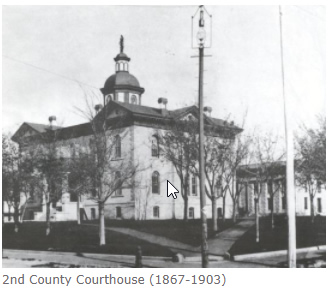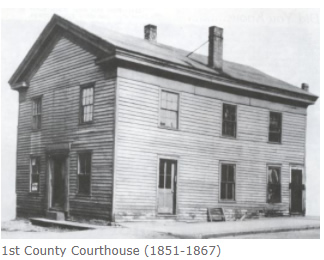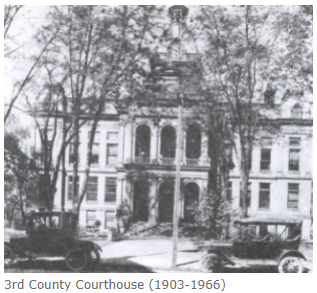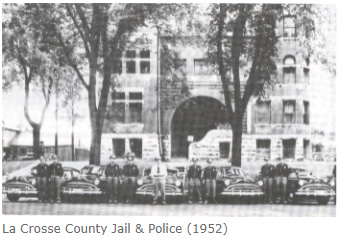
 | Sheriff's Office |
About Us
Sheriff John Siegel – send email
Our Mission: The La Crosse Sheriff's Office is committed to improving the quality
of life for our citizens by working with them to make our community a safe place to live. We will do this by fairly enforcing our laws and by being attentive to the needs of the community.
Our History
--the following excerpts were taken from the works of Jerry Clark.
Part I
La Crosse County was created by an act of the legislature in 1851. It included land that would later be divided into Clark, Jackson, Monroe and Trempealeau Counties. The Village of La Crosse was designated the county seat. With its population of
nearly 700, it was the only big town in the area.
The original courthouse was a two story wood frame
building, 26'x36'. All government offices were on the first floor with the second flooring being used as the courtroom. The courtroom also served as a kind of community center.
The first jail was a stone building next to the courthouse, measuring 15'x15'. The ceiling was made of timbers spiked together. The attic was filled with tons of broken stones.
The idea was that if someone tried to escape through the room the would be crushed by the stones.
La
Crosse was a rowdy place at the time having a transient population of loggers and raftsmen who in turn attracted a large number of gamblers and ladies of the evening.
In February of 1857, $8,000 in bonds were sold to build a jail. The 45'x67' building was constructed at 4th and Vine streets. The jail proper was 39'x45' and had 16 cells in two tiers. Each 6'x9' cell contained two hammocks. There were 3 rooms for
women prisoners and living quarters for the sheriff and his family.
Part II
The old stone structure had proven to be inadequate both for security reasons and lack of space. The fact that La Crosse was a rowdy place had already been pointed out. In 1857 a vigilante committee was formed to combat crime and debauchery. Their
first order of business was to burn two brothels. Community leaders argued that lawful procedures should be followed to rid the city of undesirable elements. A City Marshal/Constable system was implemented. The City Police was formed in 1870.
The new jail was built on a block between Vine and State streets on 4th Street. In 1867 a new courthouse was added to the same property. Records show the jail was a massive
structure constructed from 200 cords of stone. There is no history of any escapes.
Part III
The turn of the century had brought many changes to the La Crosse area. The automobile was introduced early and better roads allowed for more expansion beyond the city.
By 1920, the City Police department had grown to 40 officers while other communities met their law enforcement needs with town marshals and constables.
The Sheriff's Department consisted of 4 full-time employees well into the 1920's. In 1927, the County board authorized the following annual pay scale. Sheriff - $2,000, Undersheriff
- $1,200, two jailers at $1,020 each and six deputies at $25 per year.
The jail was located at 10th and Ziesler streets. It contained living quarters for the sheriff and
his family. His wife acted as cook for the jail and matron when there was a female prisoner. The county paid board based on the number of prisoners.
1924 saw the election of Sheriff W.H. Ristow who in 1926 became the only sheriff in La Crosse County history to be removed from office.
Part IV
In the last segment it was mentioned that the introduction of the automobile and better roads allowed the community to prosper in the early 1900's. Cars, trucks
and busses also brought a new set of problems for law enforcement.
By 1905, La Crosse had one car dealership
and two automobile repair shops. It was 1910 before a record of the first gas station appears. In 1911, the City of La Crosse decided it needed a speed limit. 6 MPH was established downtown and 15 MPH on the remaining streets.
Traffic problems weren't much of a concern in the rural area until the early 1920's. At that time, La Crosse County established a series of arterial highways. Most people
simply ignored the new yellow stop signs.
In 1925, La Crosse County adopted its first traffic ordinances.
They established that people under 16 needed an adult along to operate a vehicle; speed limits were 30 MPH on public highways, 15 MPH within the limits of the village, 12 MPH in cemeteries, parks, near schools, hospitals, and on the grounds of the
poor farm. All vehicles over 2 tons had to have a mirror. All vehicles were required to have brakes or a bell, horn or other signal device. Head lamps were required after dark, but tail lamps aren't mentioned until an amendment in 1927. The 1927 amendment
also mentions that vehicles over two tons are now required to have brakes.
The only employees in the
sheriff's office were two jailers and the undersheriff. In order to enforce these new laws the ordinance provided for the hiring of a special deputy who would only work on traffic enforcement. His duties were directed by the Committee For Roads and
Bridges. The first traffic officer was Ralph Bradley. He started his duties June 1, 1925. He was paid $125 per month and supplied with a motorcycle and the gas he needed to run it. As of October 31 of that year, he had generated $912 in fines and
cost the County $1,278.6 including the purchase of the cycle.
Minutes of the annual meeting indicated
that some board members thought that one part-time traffic officer wasn't enough. They also took up a proposal that this position be made full-time. The Board was embroiled in the Sheriff Ristow controversy at the time and took no action. In 1926
they added another part-time traffic patrolman, a S.J. Mendell. In an attempt to make traffic enforcement more effective without increasing the budget further, they directed the Sheriff to deputize the board members, Highway Commissioner, and road
maintenance personnel.
It wasn't until 1930 that the Board decided that they needed a full-time La Crosse
County Highway Police Department. They hired a "Captain In Charge" to run the department and authorized the two former part-time employees to become full-time.
Photo Gallery
|
 |
|
|





